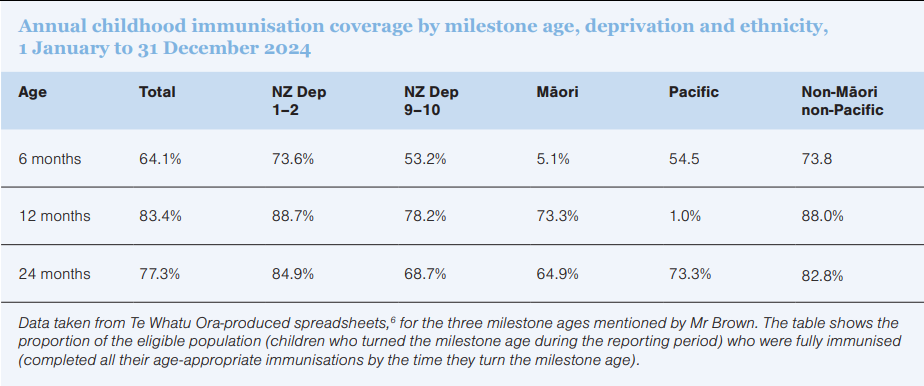For older people and frail people, the long-term benefit of medicines reduces and the potential for harm from adverse effects increases. When the benefit–risk balance changes in this way, medicine review and optimisation are important to simplify the therapeutic regimen, reduce inappropriate medicines and minimise risks. In this article, pharmacist prescriber Linda Bryant uses two case studies to illustrate important considerations during medicine reviews
Why minister’s good news on immunisation needs a closer look
Why minister’s good news on immunisation needs a closer look
The Government is celebrating a ‘steady improvement’ in childhood immunisation – but focusing on overall rates can hide who’s being left behind. Gabrielle Baker takes a deeper dive into data and reveals persistent gaps for Māori and high-needs communities
In early May, health minister Simeon Brown issued a media statement to say there has been “steady improvement in childhood immunisation rates across the country”.1 The good-news update was well-timed, coming the same day as an “unprecedented 24-hour strike” of 5000 senior hospital doctors and specialists (online 1 May).2
New Zealand has a long history of not getting childhood immunisation right – not for everyone at least – but in the past few years, a “dramatic decline in Aotearoa childhood immunisation rates has occurred, associated with the COVID-19 pandemic”.3 So the good news is welcome. But can we take it at face value?
Mr Brown says that there were particularly strong gains at six, 12 and 24 months and that these gains were across the country but especially notable in Tairāwhiti, the West Coast and Taranaki. His statement did not indicate whether there were different patterns by ethnicity.
Focusing on the total population only tells part of the story. While it can show how well something works for most people, it can also mask problems for smaller groups or hide that some groups benefit more than others. In other words, “total population” is a shorthand that works when trying to spin a story, but it isn’t good at monitoring system performance.
This is something to watch in all parts of government activity, especially in areas where Māori or Pacific populations have been let down before – as is the case with immunisation.
Immunisation coverage is an area where we should be especially sensitive to the use of total population data. As the Immunisation Taskforce put it in 2022, “Aotearoa has always had inequitable immunisation coverage, with Māori, the poor and Pacific populations bearing the brunt of this systemic indifference”.4
So, I decided to go through the more detailed data spreadsheets available online. However, the data Mr Brown’s media statement is based on is not yet available, which meant I couldn’t look at whether the good news was good news for everyone when broken down by ethnicity or relative deprivation.
Instead, I looked at the annual childhood immunisation coverage by age, district, region, deprivation and ethnicity as of December 2024. This period is the most up-to-date data on the Health New Zealand Te Whatu Ora website,5 but I stress that this is not the data the media statement was based on. There are some clear patterns in this data, which might be best seen in the table below.
What is striking in this data is the way those who are the most materially well-off (NZ Dep 1-2) and non-Māori non-Pacific ethnic groups have the highest immunisation proportion of eligible children immunised, and these proportions are very similar. They are also higher than the total population figures.
Equally striking is that Māori children are the least likely to be fully immunised at every milestone age. Only 45.1 per cent of the youngest Māori pēpi are fully immunised at six months old, which is incidentally slightly worse than in December 2023 (46.9 per cent).
There is no additional statistical analysis from me here, policy rather than maths being my area of expertise, so there could be even more to the picture to understand. But, nevertheless, I think this table makes the point that total population isn’t telling us the whole story
Perhaps it is a bit much to expect a ministerial media statement to include a proper analysis of system performance.
Certainly, nuance isn’t easily communicated in 300 words. But in an area that is infamous for its inequities and so closely connected to outcomes for tamariki Māori, it is still reasonable to expect any good news to be subject to scrutiny.
I look forward to seeing the more detailed data tables from Te Whatu Ora to see how the story goes – beyond the total population headline.
Gabrielle Baker (Ngāpuhi, Ngāti Kuri) is an independent health policy consultant
TELL US WHAT YOU THINK
Send a Letter to the Editor to editor@nzdoctor.co.nz
We're publishing this article as a FREE READ so it is FREE to read and EASY to share more widely. Please support us and our journalism – subscribe here
One of the benefits of subscribing is you will also be able to share your thoughts about what you read with others in our Comment Stream. You can also take notes on what you read with Capture
- New Zealand Government. May 2025. See: tinyurl.com/3f3wcsus
- See: nzdoctor.co.nz/article/news/senior-hospital-doctors-strike-protest-stalled-pay-talks
- New Zealand Government. Immunisation Taskforce. 2022. See: tinyurl.com/yc7xvd4r
- Ibid.
- New Zealand Government. See: tinyurl.com/bp89mbfy
- Ibid.









![New Zealand Doctor Rata Aotearoa editor Barbara Fountain, RNZCGP president elect and Tauranga-based specialist GP Luke Bradford, Ministry of Health clinical chief advisor rural health Helen MacGregor, and Health New Zealand Te Whatu Ora clinical director primary and community care Sarah Clarke [Image: NZD]](/sites/default/files/styles/thumbnail_cropped_100/public/2025-05/1.%20Barbara%20Fountain%2C%20Luke%20Bradford%2C%20Helen%20MacGregor%20and%20Sarah%20Clarke.jpg?itok=091NETXI)
![Ngāti Porou Oranga specialist GP Elina Pekansaari and Te Nikau Hospital specialist in general practice and rural hospital medicine David Short [Image: NZD]](/sites/default/files/styles/thumbnail_cropped_100/public/2025-05/2.%20Elina%20Pekansaari%20and%20David%20Short.jpg?itok=h5XfSBVM)
![Locum specialist GP Margriet Dijkstra and OmniHealth regional operations manager (southern) Patricia Morais-Ross [Image: NZD]](/sites/default/files/styles/thumbnail_cropped_100/public/2025-05/3.%20Margriet%20Dijkstra%20and%20Patricia%20Morais-Ross.jpg?itok=jkrtRfJC)
![Golden Bay dairy farmer and dairy industry health and safety doctoral student Deborah Rhodes, and Golden Bay Community Health specialist GP Rachael Cowie [Image: NZD]](/sites/default/files/styles/thumbnail_cropped_100/public/2025-05/4.%20Deborah%20Rhodes%20and%20Rachael%20Cowie.jpg?itok=oM0_GcJc)
![Hauora Taiwhenua clinical director rural health Jeremy Webber, Australian College of Rural and Remote Medicine president Rod Martin and Observa Care director of business operations Deborah Martin, the wife of Dr Martin [Image: NZD]](/sites/default/files/styles/thumbnail_cropped_100/public/2025-05/5.%20Jeremy%20Webber%2C%20Rod%20Martin%20and%20Deborah%20Martin%2C%20the%20wife%20of%20Dr%20Martin.jpg?itok=P_aGmX_H)
![Spark Health chief executive John Macaskill-Smith and client director Bryan Bunz [Image: NZD]](/sites/default/files/styles/thumbnail_cropped_100/public/2025-05/6.%20John%20Macaskill-Smith%20and%20Bryan%20Bunz.jpg?itok=5yJvVZ0I)
![Associate dean (rural) Kyle Eggleton, third-year medical student Roselle Winter, and second-year pharmacy student Alina Khanal, all from the University of Auckland [Image: NZD]](/sites/default/files/styles/thumbnail_cropped_100/public/2025-05/7.%20Kyle%20Eggleton%2C%20Roselle%20Winter%20and%20Alina%20Khanal.jpg?itok=RQLd3TEs)
![Health New Zealand Te Whatu Ora clinical editor and specialist in general practice and rural hospital medicine Anu Shinnamon, and Whakarongorau chief clinical officer Ruth Large [Image: NZD]](/sites/default/files/styles/thumbnail_cropped_100/public/2025-05/8.%20Anu%20Shinnamon%20and%20Ruth%20Large.jpg?itok=i5TMswY9)
![Te Kahu Hauora Practice specialist GP Jane Laver and Ngāti Kahungunu ki Tāmaki-nui-a-Rua chief operations manager Tania Chamberlain [Image: NZD]](/sites/default/files/styles/thumbnail_cropped_100/public/2025-05/9.%20Jane%20Laver%20and%20Tania%20Chamberlain.jpg?itok=jtMklaCZ)